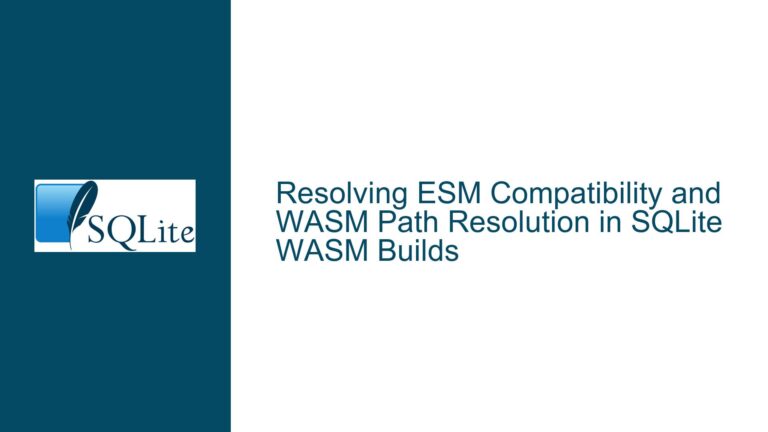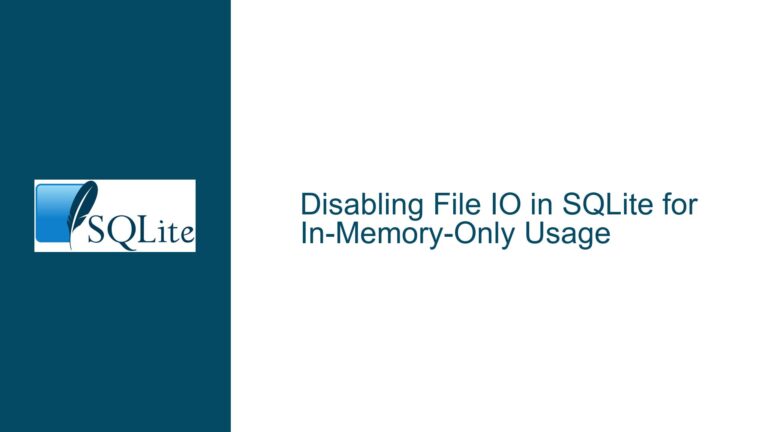SQLite WAL and B-Tree Synchronization Mechanisms
Issue Overview: WAL and B-Tree Synchronization in SQLite
SQLite employs a Write-Ahead Logging (WAL) mechanism to ensure data integrity and consistency. The WAL file acts as a buffer where changes are recorded before they are applied to the main database file, which is structured as a B-Tree. This approach allows SQLite to provide atomic transactions and crash recovery. However, the synchronization between the WAL and the B-Tree can raise questions about how SQLite handles scenarios where writes to the WAL succeed but subsequent updates to the B-Tree fail, or where the system crashes before marking a WAL record as applied.
The core issue revolves around the sequence of operations:
- A write operation is first recorded in the WAL.
- The changes are then applied to the B-Tree.
- A marker is updated to indicate that the WAL record has been successfully applied to the B-Tree.
If the system crashes after step 1 but before step 3, SQLite must ensure that the changes are not lost or applied incorrectly upon restart. This raises concerns about potential double-applications of changes, especially in cases where operations like UPDATE myTable SET ID = ID + 1 are involved. Understanding how SQLite manages this synchronization is crucial for developers working on systems where data integrity and consistency are paramount.
Possible Causes: Why WAL and B-Tree Synchronization Can Fail
The synchronization between the WAL and the B-Tree can fail due to several reasons, primarily stemming from system crashes or power failures. These failures can occur at any point during the three-step process outlined above. For instance, if the system crashes after the WAL write (step 1) but before the B-Tree update (step 2), the WAL will still contain the unapplied changes. Upon restart, SQLite will attempt to reapply these changes to the B-Tree. However, if the crash occurs after the B-Tree update (step 2) but before the marker is updated (step 3), SQLite will also reapply the changes, potentially leading to concerns about double-application.
Another potential cause of synchronization issues is the granularity of the WAL mechanism. SQLite operates at the page level rather than the record level. This means that changes to individual records are recorded as changes to entire pages in the WAL. While this approach simplifies the process of applying changes from the WAL to the B-Tree, it can also lead to inefficiencies, especially if multiple transactions modify the same page. In such cases, the WAL may contain multiple versions of the same page, each corresponding to a different transaction. This can complicate the process of determining which changes have already been applied to the B-Tree.
Furthermore, the delay between writing to the WAL and applying changes to the B-Tree can also contribute to synchronization issues. SQLite defers the application of changes from the WAL to the B-Tree until it is safe to do so, typically when there are no active read transactions that require the older versions of the pages. This delay can increase the window of opportunity for crashes or failures to occur, potentially leading to inconsistencies between the WAL and the B-Tree.
Troubleshooting Steps, Solutions & Fixes: Ensuring Robust WAL and B-Tree Synchronization
To ensure robust synchronization between the WAL and the B-Tree, SQLite employs several mechanisms that address the potential issues outlined above. These mechanisms are designed to guarantee that changes are applied correctly, even in the event of a system crash or power failure.
1. Atomic Commit and Rollback: SQLite’s WAL mechanism ensures that transactions are atomic, meaning that either all changes in a transaction are applied, or none are. This is achieved by writing all changes to the WAL before attempting to apply them to the B-Tree. If a crash occurs before the changes are applied to the B-Tree, SQLite will reapply the changes from the WAL upon restart. If the crash occurs after the changes are applied but before the marker is updated, SQLite will still reapply the changes, but since the changes are idempotent (applying them multiple times has the same effect as applying them once), this does not lead to inconsistencies.
2. Page-Level Granularity: SQLite’s decision to operate at the page level rather than the record level simplifies the process of applying changes from the WAL to the B-Tree. When changes are applied to the B-Tree, entire pages are overwritten, ensuring that the B-Tree reflects the most recent state of the database. This approach eliminates the need to merge changes from the WAL with the existing data in the B-Tree, reducing the complexity and potential for errors.
3. Checkpointing: SQLite periodically performs checkpoints, during which changes from the WAL are applied to the B-Tree and the WAL is truncated. Checkpointing reduces the size of the WAL and ensures that changes are promptly applied to the B-Tree. This process is carefully managed to avoid conflicts with active read transactions, ensuring that older versions of pages are retained in the WAL until they are no longer needed.
4. Write-Ahead Logging Mode: SQLite’s WAL mode provides several advantages over the traditional rollback journal mode, including improved concurrency and performance. In WAL mode, readers can continue to access the database while writers are making changes, as readers can access the older versions of pages from the WAL. This separation of reads and writes reduces contention and improves overall system performance.
5. Handling Incremental Updates: In cases where operations like UPDATE myTable SET ID = ID + 1 are involved, SQLite ensures that the changes are applied correctly, even if the system crashes and the changes are reapplied. Since the WAL records the final state of the page after the update, reapplying the changes from the WAL will result in the same final state, regardless of how many times the changes are applied. This idempotent behavior ensures that incremental updates are handled correctly, even in the event of a crash.
6. Recovery Mechanism: SQLite’s recovery mechanism is designed to handle crashes and ensure that the database remains consistent. Upon restart, SQLite checks the WAL for unapplied changes and reapplies them to the B-Tree. This process is carefully managed to avoid conflicts with active transactions and ensure that the database reflects the most recent state of the data.
7. Documentation and Best Practices: SQLite’s documentation provides detailed information on the WAL mechanism and best practices for ensuring data integrity and consistency. Developers are encouraged to familiarize themselves with this documentation and follow best practices, such as performing regular checkpoints and ensuring that the system is properly configured to handle crashes and power failures.
In conclusion, SQLite’s WAL and B-Tree synchronization mechanisms are designed to ensure data integrity and consistency, even in the face of system crashes or power failures. By understanding these mechanisms and following best practices, developers can ensure that their applications remain robust and reliable, even in challenging environments.






